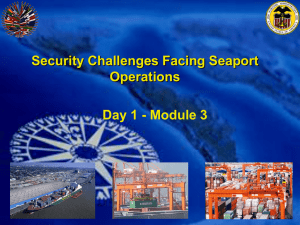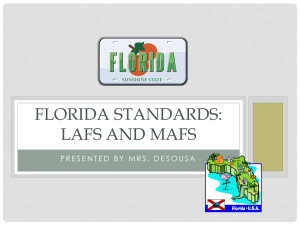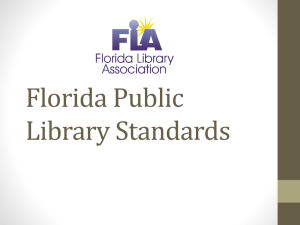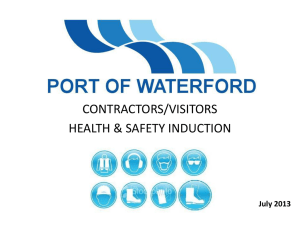A Dynamic Economic System - Florida League of Cities
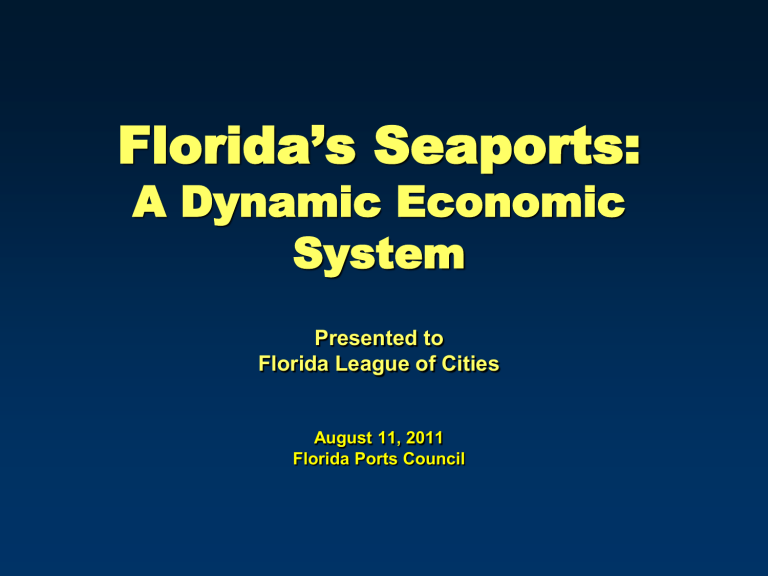
Florida’s Seaports:
A Dynamic Economic
System
Presented to
Florida League of Cities
August 11, 2011
Florida Ports Council
Florida’s Lifestyle Flows through Florida’s 14 Seaports
Almost everything Floridians wear, eat or use in their daily lives flows through our seaports.
Goods shipped through our seaports include:
Aggregates, Asphalt, Automobiles, Automotive
Parts, Aviation Fuel,
Building Materials, Clothing, Coffee, Concrete,
Copper, Dairy Products, Feeds, Fertilizers, Fruits,
Furniture,
Gasoline, Grain, Household Appliances, Leather
Goods, Lumber, Newsprint, and
Orange Juice, Paper Products, Power Plant Fuel,
Refrigerated Products, Salt, Steel.
International Trade
In 2010, Florida ranked fourth among the nation’s top exporting states.
Waterborne international trade moving through Florida seaports was valued at
$69.7 billion in 2010, accounting for nearly two-thirds of our state’s total
$126.2 billion in international trade.
Seaport Jobs and Wages
Florida seaports generate approximately 550,000 direct and indirect jobs with an average annual wage of $54,400, more than double the average wage of all other nonadvanced degree occupations --
$26,933 and over $15,000 more than the average annual wage for all occupations -- $38,470.
State and Local Tax
Revenues
In 2010, maritime cargo activities at
Florida seaports contributed more than
$1.7 billion in annual state and local tax revenues.
Florida’s 14 Public Seaports
Florida’s Seaports Are All
Different
Some are just a few acres in size; others, more than 2,000 acres.
Some are urban ports, locked in the middle of busy downtowns; others are in touristbased communities; still others are rural.
They Differ in Operations and Governance
Some are
“operating” ports; others are
“landlords.”
Some control all port operations in their area; others are surrounded by private terminals.
Some are single purpose cargo ports; others have diversified to include multiple operations.
Some are special districts; others are county or city departments.
They Differ in Resources
Adequate channels and harbors?
Landlocked or room to grow?
Rail and/or interstate access?
Supportive communities?
Sufficient revenues ?
Security needs?
But … They Share a Common
Public Purpose and
Create Florida’s Dynamic
Seaport System
The collective mission of Florida’s seaports is to “enhance the economic vitality and quality of life throughout the state by fostering the growth of domestic and foreign waterborne
commerce….”
Seaports Operate in a Unique Environment …
Focused, but dynamic transportation purpose: the movement of cargo -- bulk, boxed, or breathing.
Transportation purpose requires physical attachment to the water; seaports cannot pick up and move.
Transportation purpose creates dependency on landside connections, but often no seaport jurisdiction over essential road, rail and air infrastructure.
Seaports Are Hubs in a
Logistic Delivery Chain
Seaports are dependent upon the
Federal Government to keep their channels dredged. (Waterside)
Seaports are dependent upon the State to move goods on port for exports and off port to serve Florida’s 18 million consumers. (Landside)
Seaports are dependent upon local balance sheets to build capacity.
...With Unique Challenges
Seaports must -- and do -plan ahead to compete with neighboring states for domestic and international market share.
Surprisingly, Savannah delivers a majority of containerized goods to Florida’s consumers north of Orlando taking jobs and revenues from Floridians.
Seaports are public entities, but must function as entrepreneurs to fulfill their public purpose.
Flexibility, diversity, prompt response – these are a seaport’s competitive business imperative.
…and Unique Obligations
High economic impact and job creation expectations.
Need to move quickly to satisfy tenants and users.
Education and labor force training and development.
Compliance with applicable regulations for both waterside expansion and landside development.
State Funding Sources
State Matching Funding Sources ( over
$117m appropriated in FY 2011/12 ):
FSTED Program.
1996 and 1999 FPFC Bond Programs ($424 million).
FDOT Funds – to include SIS Funds,
District Funds, Intermodal Funds, and other FDOT discretionary funds.
Federal Funding Sources
Federal Funding Sources:
Dredging funds allocated by Federal Water
Resource Development Bills (WRDA)?
Unlike road, rail, air and transit,
NO Federal funds flow through FDOT to seaports.
TIGER Grant Funds?
Other new federal sources?
PORT CANAVERAL
Southside Cargo Terminals
Project Cost: $11M Allocation: $3.7M
South Cargo Pier 1 Widening
Pre-Construction
South Cargo Pier 4 Extension Pre-
Construction
PORT EVERGLADES
Southport Phase VIII, Container Terminal
Project Cost: $15.5M Allocation: $5.65M
Project Description: Develop a 40-acre container cargo terminal yard along
Dania Cut-Off Canal in Southport enabling the port to capture a greater portion of the expanding Far East market for which it competes with other US East Coast
PORT OF JACKSONVILLE
Mitsui O.S.K. Lines/TraPac Container Terminal
Project Cost: $220M Allocation: $17.6M
Project Description: Construction of 160-acre container terminal including bulkhead, utilities, berth construction, and dredging creating an estimated increase of 800,000 twenty-foot equivalent units (TEUs) from major global carrier.
PORT OF JACKSONVILLE
Mitsui O.S.K. Lines/TraPac Container Terminal
Project Cost: $220M Allocation: $17.6M
PORT OF MIAMI
Seaboard Marine Terminal Improvements
Project Cost: $4M Allocation: $2M
Project Description: Infrastructure improvements include pavement enhancements and drainage improvements to Seaboard Marine Terminal
Yard enabling major port tenant to increase throughput of containers by
5% annually (150,000 tons or 18,463 TEUs).
PORT OF MIAMI
Cruise Terminal B & C
Project Cost: $13.1M Allocation: $4M
Project Description: Design and construction of Cruise Terminal B & C improvements to include gantry modifications, fencing, ticket counters, partitions, reconfiguration of Customs and Border Protection facilities, carpet, tiles, drainage upgrades, security upgrades, sidewalk, runway modifications and anchor relocation. Improvements anticipated to facilitate increase volume of cruise line passengers by 75% (334,000 to 777,000), an additional homeported ship, increase of projected size of new cruise ships – 150,000 GRT – 4300 passengers.
PORT OF PALM BEACH
Cargo Transfer Facility Improvements
Project Cost: $4.51M Allocation: $2.25M
PORT PANAMA CITY
Bulk Warehouse Expansion
Project Cost: $12.5M Allocation: $1.9M
Green Circle
Bio-Energy Plant in
Jackson County
Port Panama City Bulk
Warehouse
PORT OF TAMPA
Hookers Point Improvements – Phase I
Project Cost: $40M Allocation: $10.45M
Berth 213
Extension
Regular Session 2011
Seaport Policy Changes
Duplicative and costly state security regulations repealed (311.12, F.S.)
Seaport investment identified as priority -- $100 million plus over the next five years? SEED Fund?
Permitting issues still an issue?
Dredging, Storm-Water permits, growth management planning.
